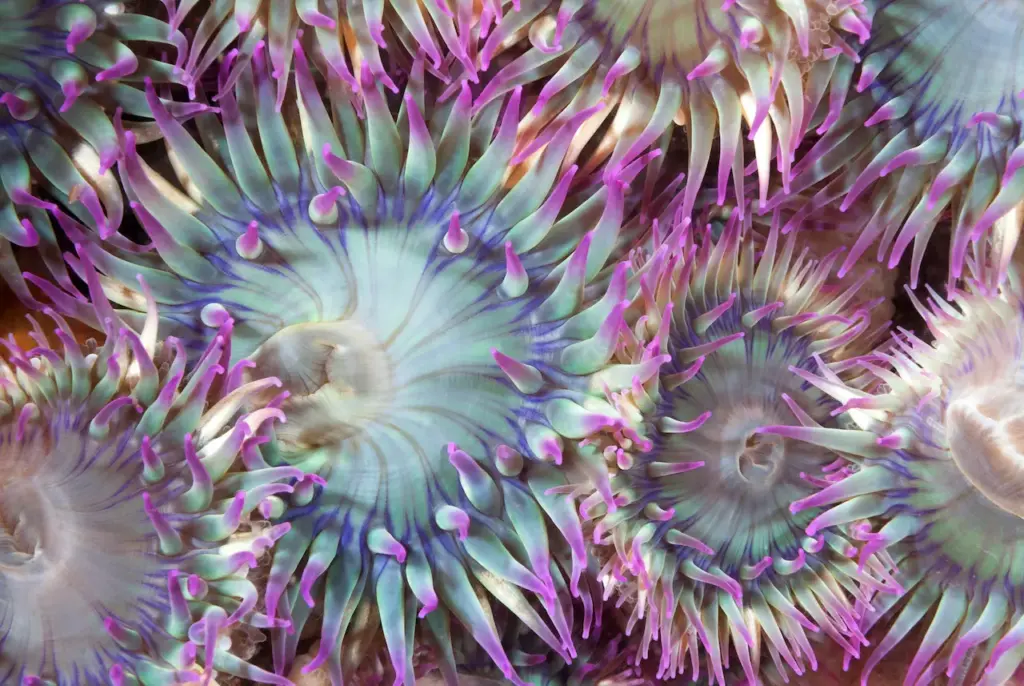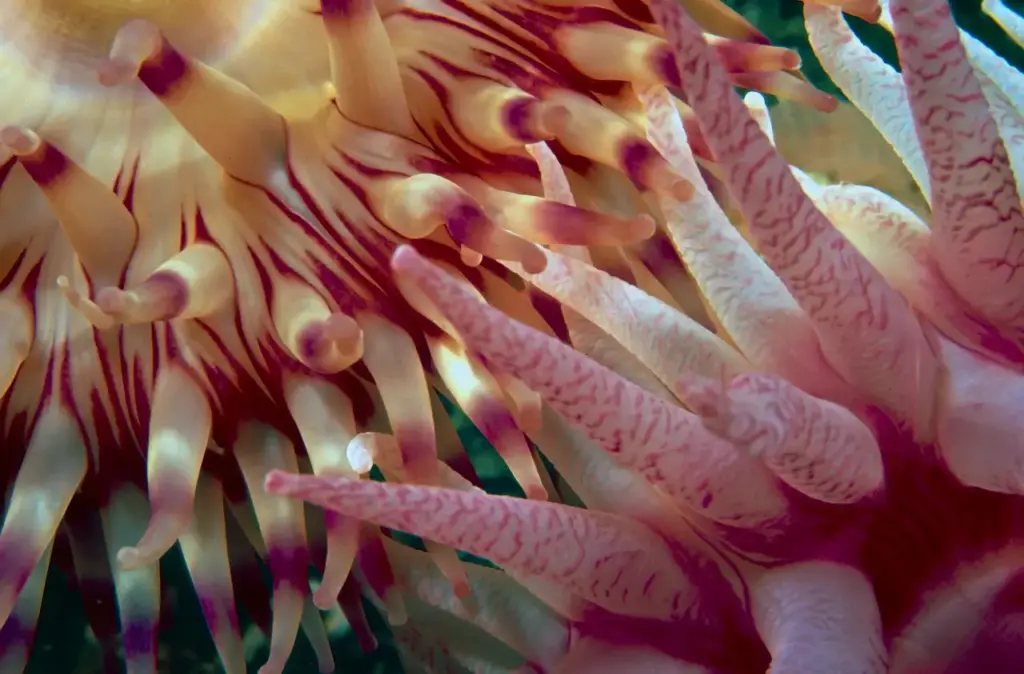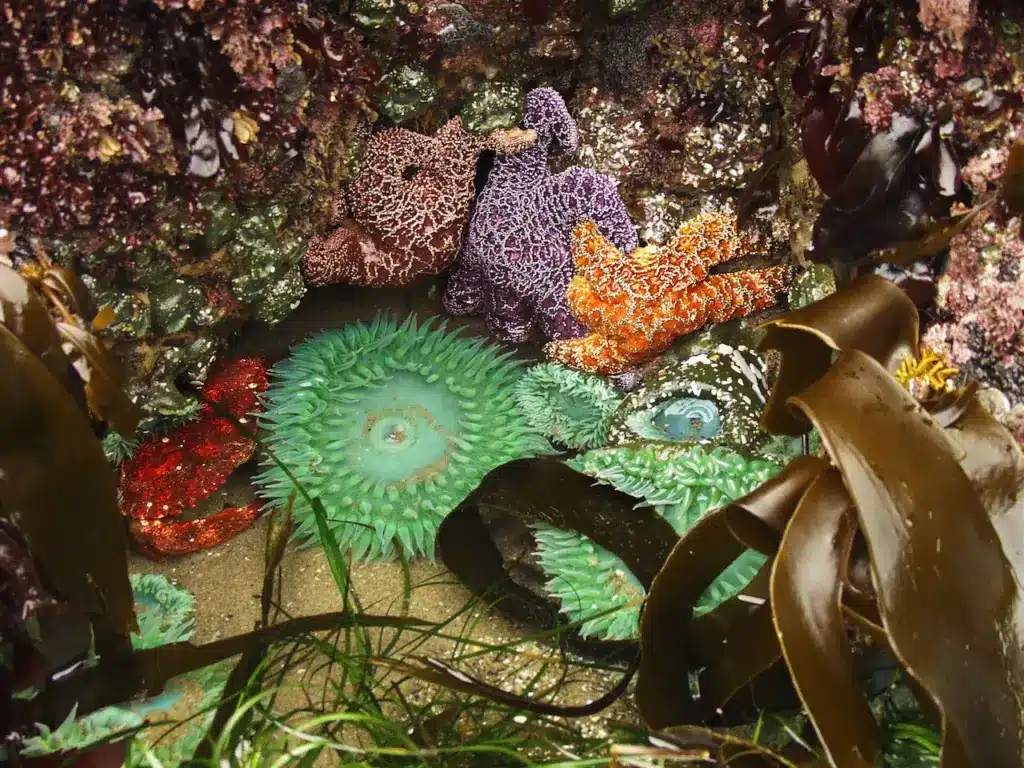Sea Anemones and Corals
Sea Anemones and Corals (Anthozoa)
For several centuries scientists have been unable to completely understand how coral reefs, among the most diverse ecosystems on the planet, could live in crystal clear tropical waters where there appears to be too little food to support them. Recent studies by scientists from Australia and America have discovered that the key lies in the extremely rough surfaces that corals have.
These surfaces cause microscopic turbulence that breaks up the ‘boundary layer’ of still water that surround most submerged objects, this then allows the corals to access a far higher percentage of the dissolved nutrients than they would be able to otherwise. This also explains the fact that corals grow more quickly in rougher waters.
Introduction
Sea anemones and corals belong to the class Anthozoa, which is part of the phylum Cnidaria. Anthozoans are characterized by their radially symmetric polyp bodies and the possession of stinging cells known as nematocysts. There are over 6,100 known species of anthozoans worldwide, making them an incredibly diverse group of marine invertebrates.
Anthozoans can be solitary or colonial. Sea anemones are solitary, with a single polyp that lives attached to rocks or other hard surfaces on the seafloor. Corals can be solitary but are more well-known for forming colonies composed of hundreds to thousands of genetically identical polyps that secrete a calcareous skeleton.
Both sea anemones and corals play important ecological roles as predators and as ecosystem engineers that provide habitat and shelter for other marine organisms.
Unfortunately, many corals are threatened by climate change, ocean acidification, pollution, and other human impacts. Understanding the biology of anthozoans can help inform conservation efforts for these iconic marine creatures.

Body Plan and Anatomy
The polyp body form of anthozoans is relatively simple, consisting of a column-shaped body attached at one end (the pedal disc) to the substrate, with a ring of tentacles surrounding the oral disc at the other end. Between the oral disc and pedal disc is the column, which contains the digestive tract.
The mouth sits in the middle of the oral disc, surrounded by hollow tentacles equipped with nematocysts that can immobilize prey with toxins. The tentacles bring food particles to the mouth, where the pharynx muscles contract to move food into the gastrovascular cavity—the main digestive compartment that runs through the body column. Waste is expelled through the mouth as well.
While the overall body plan is simple, anthozoans have complex digestive, nervous, and reproductive systems, along with specialized stinging cells. Some of the key anatomical structures and cell types include:
- Mesenteries – folding membranes that extend inwards from the body wall into the gastrovascular cavity, increasing surface area for digestion and housing reproductive organs
- Nematocysts – stinging capsules that contain coiled barbs and venom used for prey capture and defense
- Cnidocytes – specialized cells that contain nematocysts
- Zooxanthellae – photosynthetic algal symbionts that live inside the tissues of many corals and provide them with energy from photosynthesis
- Calicoblastic epithelium – a specialized tissue layer found in corals that secretes calcium carbonate to build the aragonite skeleton
- Neural net – a decentralized nerve net spread diffusely across the body rather than a central brain.
- Siphonoglyph – ciliated groove in the pharynx that helps circulate water and food particles through the gastrovascular cavity
- Basilar muscles – circular muscles that close the mouth and oral disc in sea anemones
Reproduction and Life Cycles
One key characteristic of the Anthozoa class is that polyps exhibit two distinct life stages: a sedentary polyp stage and a free-floating medusa stage.
The polyp stage predominates, with the adults of most species being benthic polyps. These polyps can reproduce asexually by budding off new clonal polyps, forming colonies. They can also reproduce sexually, with individuals producing both sperm and eggs.
Fertilized eggs develop into free-swimming larvae called planula that ultimately settle on the seafloor and transform into new polyps. In some anthozoan species, planula undergoes an intermediate medusa (jellyfish) stage before settling as polyps. However, the medusa stage has been lost in sea anemones and corals.

Habitats and Ecology
Anthozoans live exclusively in marine habitats. Most inhabit shallow tropical or temperate seas, although some species are found in deeper, colder waters.
Sea anemones are abundant in rocky intertidal zones where they attach to hard substrates like rocks, shells, or pier pilings. Tropical corals form elaborate reef structures in shallow photic zones, while deep-sea corals live hundreds of meters down, beyond the reach of light.
Anthozoans feed on passing zooplankton, small fish, and other prey, catching food with their tentacles. Corals form a symbiotic relationship with photosynthetic algae called zooxanthellae, which live inside coral tissues. The zooxanthellae provide corals with glucose, glycerol, and amino acids from photosynthesis, allowing corals to grow faster and form large reef structures.
As sedentary filter feeders, anthozoans play a key role in marine food webs and ecosystem dynamics. Coral reefs, in particular, are among the most diverse and productive ecosystems on the planet, providing habitat and shelter for millions of species. However, coral reefs are increasingly threatened by human activities.
Major Groups
There are two main subclass groups within the Anthozoa:
Octocorallia (Alcyonaria)
- Include soft and stony corals
- Polyps have 8 feather-like pinnate tentacles
- Examples: sea fans, sea whips, blue coral
Hexacorallia (Zoantharia)
- Polyps have 6 simple tentacles or multiples of 6
- This group includes sea anemones and stony corals
- Examples: tube anemones, carpet anemones, stony corals
Sea Anemones
Sea anemones are solitary anthozoans made up of a single large polyp. They live attached to hard surfaces on the seafloor, often in rocky intertidal zones where they can be exposed at low tide. There are over 1,200 species of sea anemones globally. Some key features:
- Solitary; reach up to 10 cm in diameter
- Approximately equal in length and width when expanded
- Column smooth and tapered, topped with flattened oral disc
- Have over 100 tentacles arranged in multiples of 6
- Use tentacles to sting and immobilize passing prey
- Can reproduce through budding and sexually
- Some species form symbiotic relationships with anemonefish and anemone crabs
Some of the most common sea anemone groups include:
- Tube anemones (Ceriantharia) – live buried in soft sediments with just their tentacles exposed
- Carpet anemones (Stichodactyla) – have large oral discs that allow them to crawl and glide across surfaces
- Beadlet anemones (Actinia) – abundant small intertidal species with brightly colored tentacles
- Giant green anemones (Anthopleura) – large bright green intertidal species up to 20 cm across

Corals
Corals are marine invertebrates in the class Anthozoa that form colonies of genetically identical polyps. Each polyp secretes a calcareous exoskeleton, and over generations, these skeletons grow, merge, and accumulate to form coral reef frameworks.
There are over 2,300 known species of reef-building stony corals alone that construct the elaborate coral reef ecosystems found in tropical shallow waters. Here are some key traits of corals:
- The majority live in tropical oceans near the equator
- Secrete a hard exoskeleton of calcium carbonate (aragonite)
- Polyp tentacles have stinging cells for capturing plankton
- Many species harbor symbiotic zooxanthellae in their tissues for energy from photosynthesis
- Form colonies through asexual reproduction by budding
- Colonies can grow massive over hundreds of years
The two main types of stony corals that build modern reefs are:
Brain corals (Faviidae)
- Massive dome or brain-like colonies
- Prominent grooves between coral polyps
- Include boulder brain (Colpophyllia) and maze corals
Branching corals (Acroporidae)
- Form elaborate branching structures
- More fragile but faster-growing
- Key reef-builders in shallow waters
- Include staghorn (Acropora cervicornis) and table corals
Soft corals (Alcyonacea) and black corals (Antipatharia) also belong to the Anthozoa but do not produce reef structures. There are also deep-sea corals that form habitats in dark, cold waters hundreds of meters down.
Feeding Ecology and Diets
Prey Capture
Anthozoans are predominately carnivorous, feeding on zooplankton, small fish, and other prey. Their stinging tentacles allow them to capture prey efficiently.
Sea anemones use specialized cells called cnidocytes to fire stinging nematocysts when prey makes contact with tentacles. The nematocyst barbs inject toxins that immobilize prey.
Corals use similar stinging cells to paralyze zooplankton that get trapped in their mucus-lined tentacles. The tentacles then move prey to the central mouth for ingestion into the gastric cavity.
Digestion
Prey is digested internally within the gastrovascular cavity. Sea anemones can evert their stomach out through their mouth to externally digest larger prey like fish.
Corals use their mesenterial filaments – folds on the inner gastrovascular lining covered in stinging cells and digestive enzymes – to help break down prey. Indigestible particles are eventually expelled through the mouth.
Zooxanthellae provide additional nutrition to corals through photosynthetic products. The coral provides the algae with shelter, carbon dioxide, and inorganic nutrients. This mutualistic symbiosis facilitates the growth of large coral colonies.
Responses to Prey Abundance
When zooplankton is abundant, such as during spawning events, anthozoans can capture prey at higher rates. Some expand their oral discs and tentacles to maximize feeding surface area.
If prey becomes scarce, anthozoans exhibit lower metabolic rates and can shrink their bodies. Some corals reduce tissue thickness and growth rates to conserve energy. Sea anemones may retract their tentacles completely until prey returns.
This ability to adjust their morphology and metabolism based on food availability helps anthozoans survive fluctuating environmental conditions.
Defense Mechanisms
Camouflage and Warning Coloration
Some anthozoans blend in with their surroundings to avoid being eaten. Tube anemones are buried in sediment with only their colorless tentacles exposed.
Certain corals resemble rocks or algae. Other species have bright aposematic coloration to warn predators of their stinging cells, like brightly colored tropical sea anemones.
Chemical Defenses
In addition to stinging nematocysts, some anthozoans produce protective mucus that contains toxins noxious to potential predators. The bubble-tip sea anemone (Entacmaea quadricolor) and other species eject mucus laced with proteins harmful to fish.
Soft corals secrete terpenoid compounds that deter fish and urchin grazing. These chemical defenses supplement the stinging cells used for prey capture.
Hiding and Avoidance Behaviors
If disturbed, some sea anemones can detach from substrates and roll into a ball to avoid damage, hiding their oral discs and tentacles inside.
Coral polyps exhibit retraction reflexes when disturbed, quickly pulling in their tentacles to avoid predation. This reduces the risk of tissue damage or nematocyst firing, which takes energy to replace.
These hiding and retraction behaviors help conserve energy and prevent injury when threats are detected.
Symbiotic Relationships for Protection
Some tropical sea anemones form symbiotic relationships with anemonefish, who are immune to their nematocysts. The fish nestle in the anemone’s tentacles, gaining protection from predators. In return, they chase away butterflyfish that eat sea anemones.
Corals also form partnerships with other species, like crustaceans and cardinalfish, who gain shelter within the reef structure. Having these symbionts helps protect the coral habitat.
Environmental Adaptations and Acclimatization
Anthozoans have adapted in many ways to life in marine environments, allowing them to inhabit diverse ocean conditions.
Intertidal Zone Adaptations
Intertidal anemones like green sea anemones (Anthopleura spp.) have adapted to survive periodic exposure during low tides. They have muscular pedal discs to cling tightly to rocks. Mucus helps retain moisture. They can retract their tentacles to avoid desiccation when emersed.
Coral Reef Adaptations
Corals have adaptations, allowing them to thrive in warm tropical seas. Zooxanthellae give them energy from sunlight. Their light, calcareous skeletons avoid being smashed by waves. Complex growth forms like branching corals resist damage from currents and storms.
Deep Sea Adaptations
Cold-water corals in deep oceans feed efficiently to cope with low food supplies. They extend long tentacles and have large polyps. Some species lack zooxanthellae since less light penetrates to hundreds of meters depth. Their growth rates are very slow.
Acclimatization Responses
Anthozoans exhibit acclimatization at physiological and molecular levels in response to environmental changes. For example, higher water temperatures induce the expression of heat shock proteins that help prevent protein damage.
Symbiotic algae in corals can shuffle and shuffle their symbiont types to utilize those most temperature tolerant. Such acclimatization responses help anthozoans adjust to varying marine conditions over their lifetimes.
Conservation Status and Solutions
IUCN Red List Status
Over 75 species of anthozoans are currently listed as threatened by the International Union for Conservation of Nature (IUCN), including 58 critically endangered species.
Major groups at the highest risk include staghorn corals, pillar corals, and elephant ear sponges in the Caribbean. Their numbers are rapidly dwindling due to climate change, disease, habitat destruction, and other human impacts.
Protecting Reef Habitats
Marine reserves that limit or prohibit fishing and tourism activities can effectively protect coral habitats if well managed and enforced.
For example, fully protected zones of Australia’s Great Barrier Reef Marine Park have maintained higher coral cover than unprotected areas open to fishing. Similar marine protected areas are needed globally.
Assisted Evolution and Intervention
More direct actions like coral farming, assisted evolution, probiotic bacterium use, and transplantation of heat-tolerant corals may help rescue declining reefs.
While controversial, such interventions are now being tested to help struggling corals adapt to warming and acidifying oceans. Further research can clarify best practices going forward.
Reducing Local Impacts
Improving coastal development policies, reducing agricultural runoff, and properly treating sewage can lessen land-based pollution that degrades water quality.
Curtailing destructive fishing like trawling and blast fishing takes the pressure off fragile reef ecosystems. Such actions reduce local stressors that diminish coral resilience to climate change.
Global Climate Action
Ultimately, the future of coral reefs depends on addressing the root cause of climate change by transitioning economies away from fossil fuels towards renewable energy and enacting policies that drastically reduce greenhouse gas emissions worldwide.
Global cooperation and political will are critical to limit warming before mass coral extinctions occur.
Threats to Coral Reefs
Coral reefs are incredibly diverse and productive ecosystems that support over 25% of all marine species. However, human activities have led to massively declining coral populations worldwide. Some major threats facing modern coral reefs include:
- Climate change and ocean warming – Elevated sea temperatures cause corals to bleach and die. More frequent/intense El Niño events have caused mass bleaching events.
- Ocean acidification – Increased ocean CO2 levels make it harder for corals to build skeletons.
- Pollution and runoff – Nutrient pollution and sedimentation from agriculture and development smother and damage reefs.
- Destructive fishing – Methods like dynamite and cyanide fishing destroy reef structures.
- Invasive species – Invasive algae, seaweed, and predators like lionfish outcompete and consume native coral reef species.
- Disease outbreaks – Rising temperatures facilitate more marine epidemics that wipe out corals like white band disease.
- Physical damage from tourism – Unregulated tourism leads to breakage from snorkeling, anchors, souvenir removal, etc.
Conservation efforts are underway globally to study reef resilience, reduce local stressors, and protect critical habitats through marine reserves. Ultimately, curbing climate change and ocean acidification is needed to prevent widespread reef ecosystem collapse.
Conclusion
Sea anemones and corals belong to the diverse Anthozoa class and play critical roles as predators and habitat providers in marine ecosystems. Their simple body plan centers around the polyp form specialized for filter feeding. Stony corals, in particular, can form massive reef frameworks that support immense biodiversity.
However, climate change and other human impacts now threaten the future of the world’s coral reefs. Understanding anthozoan biology provides key insights needed for evidence-based conservation strategies aimed at preserving these iconic marine organisms.

